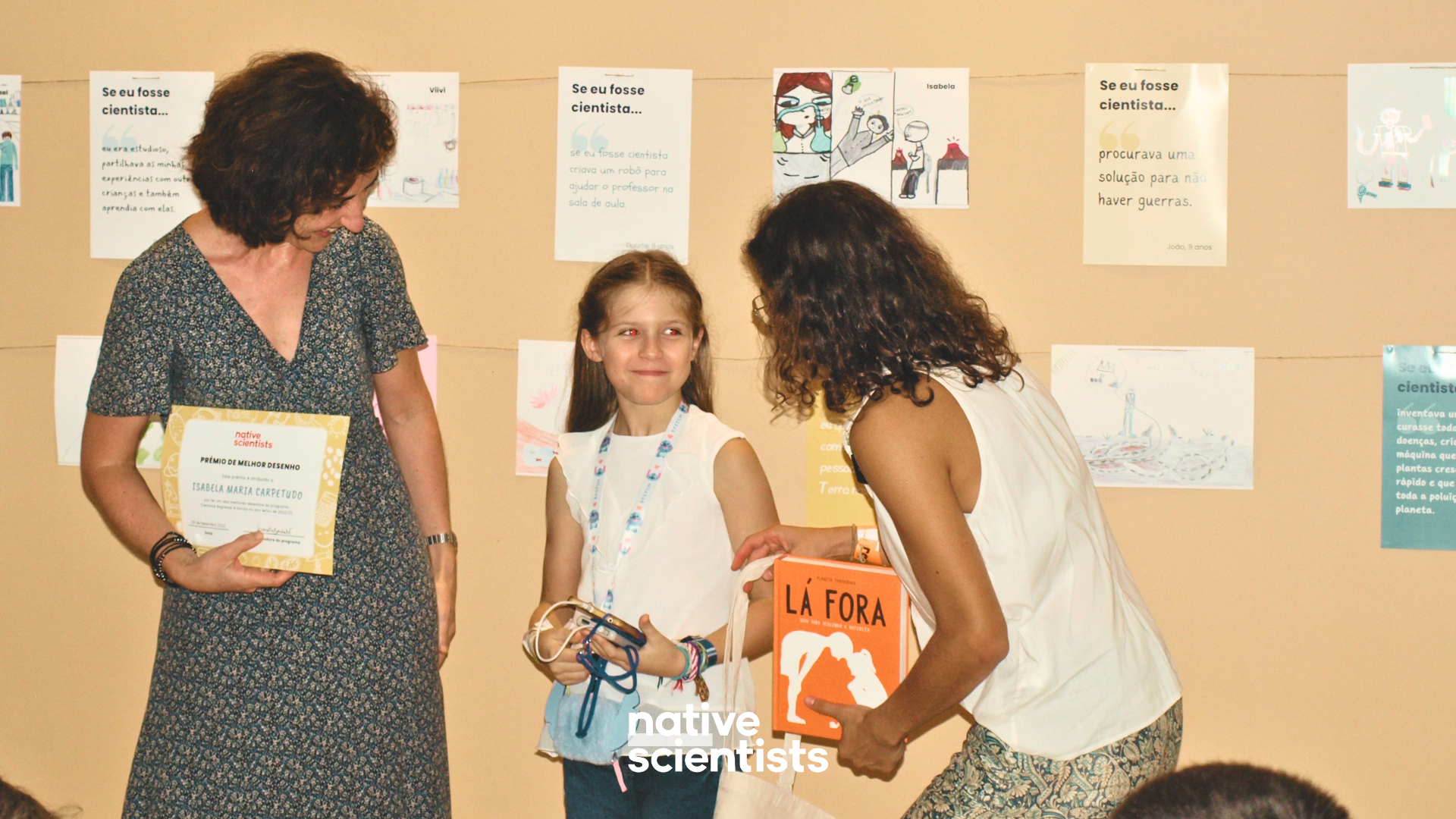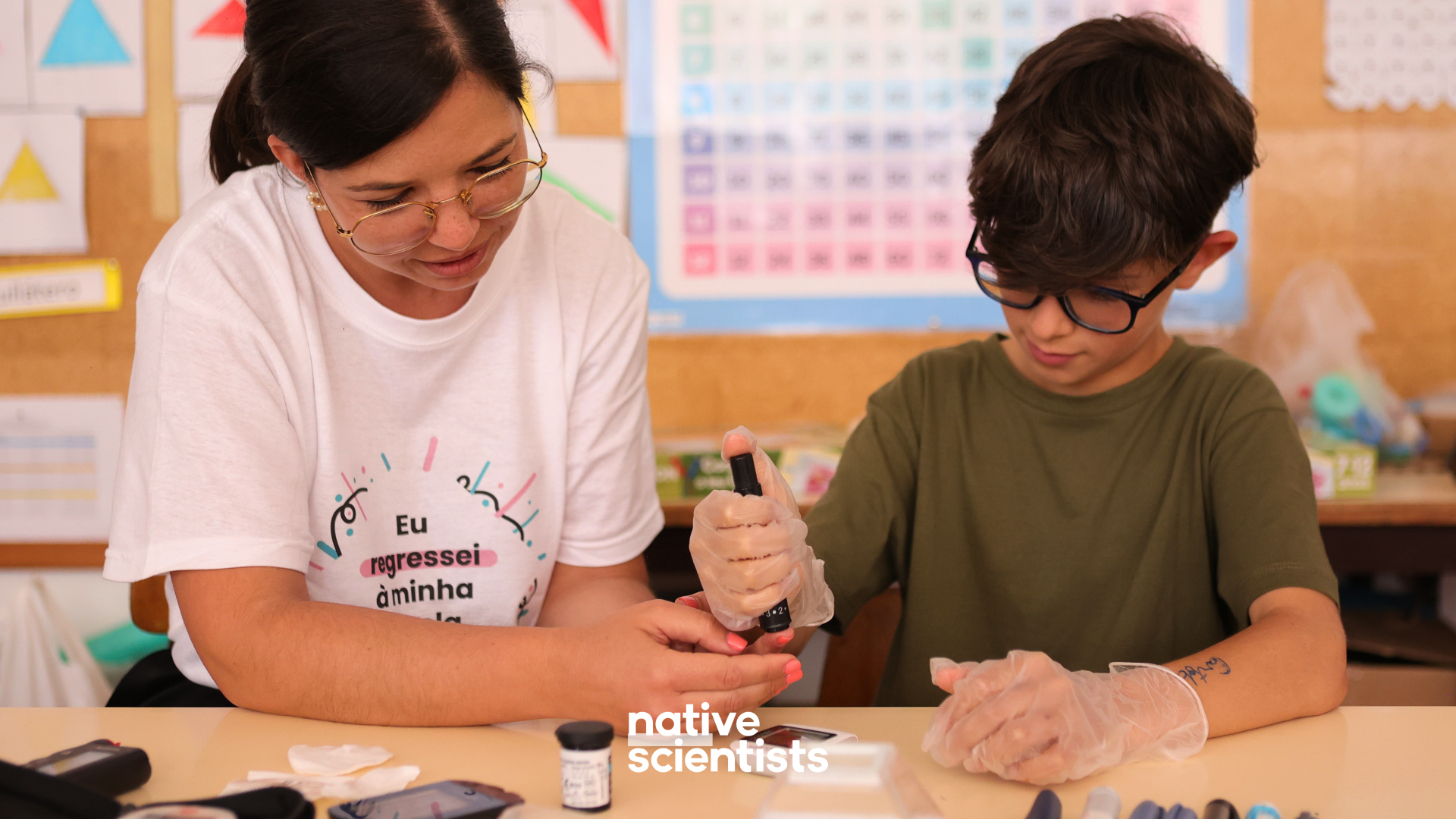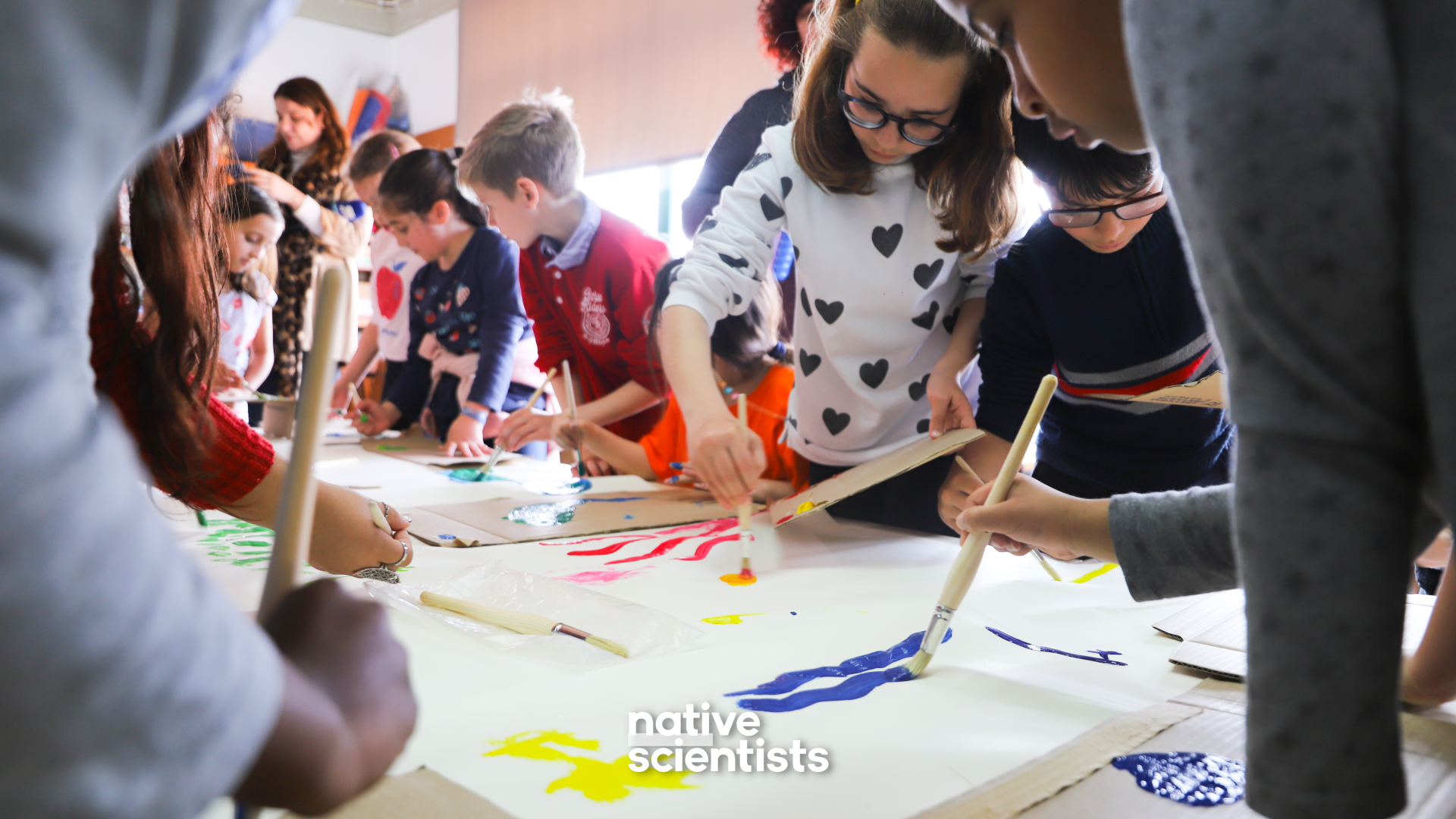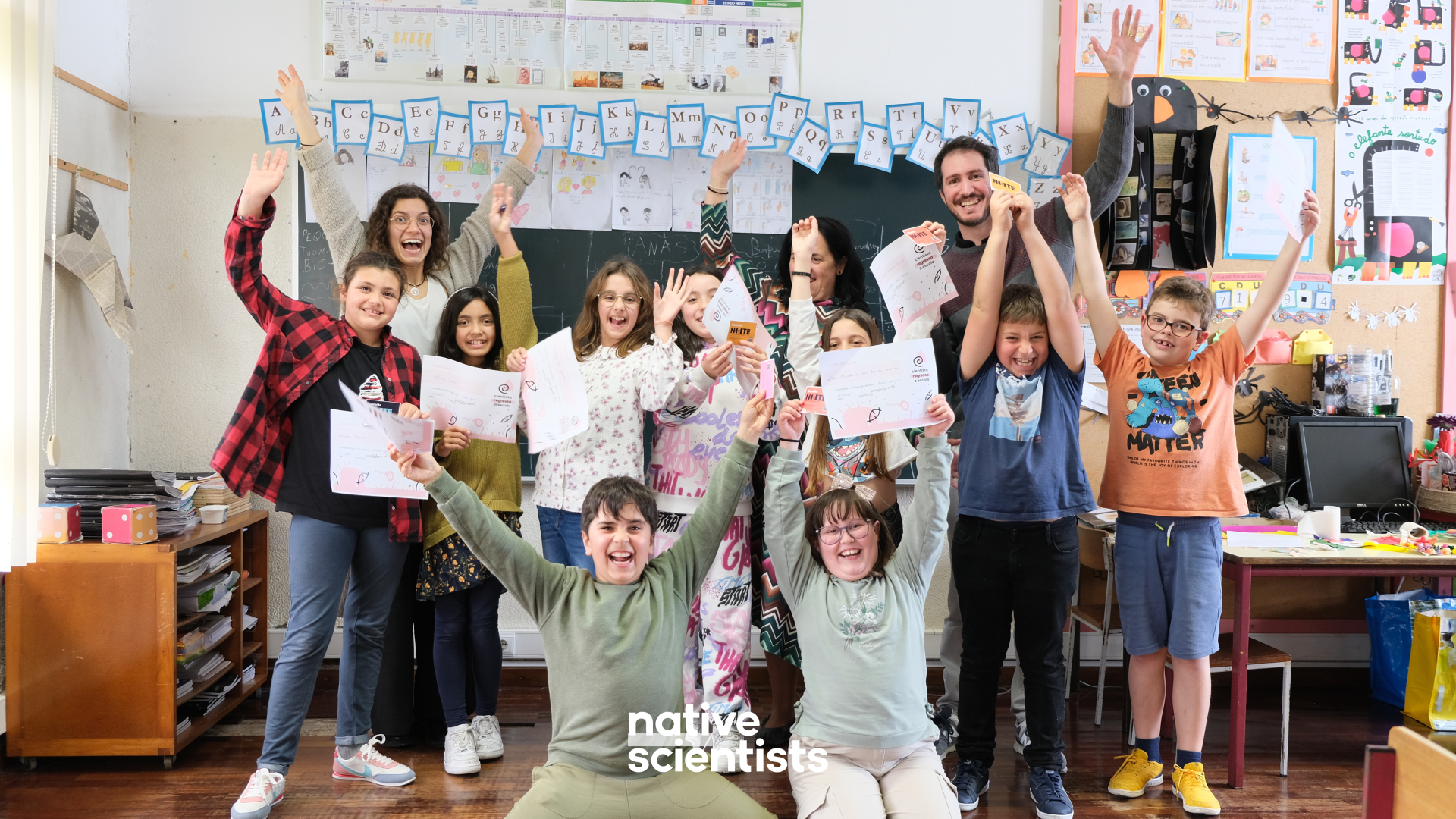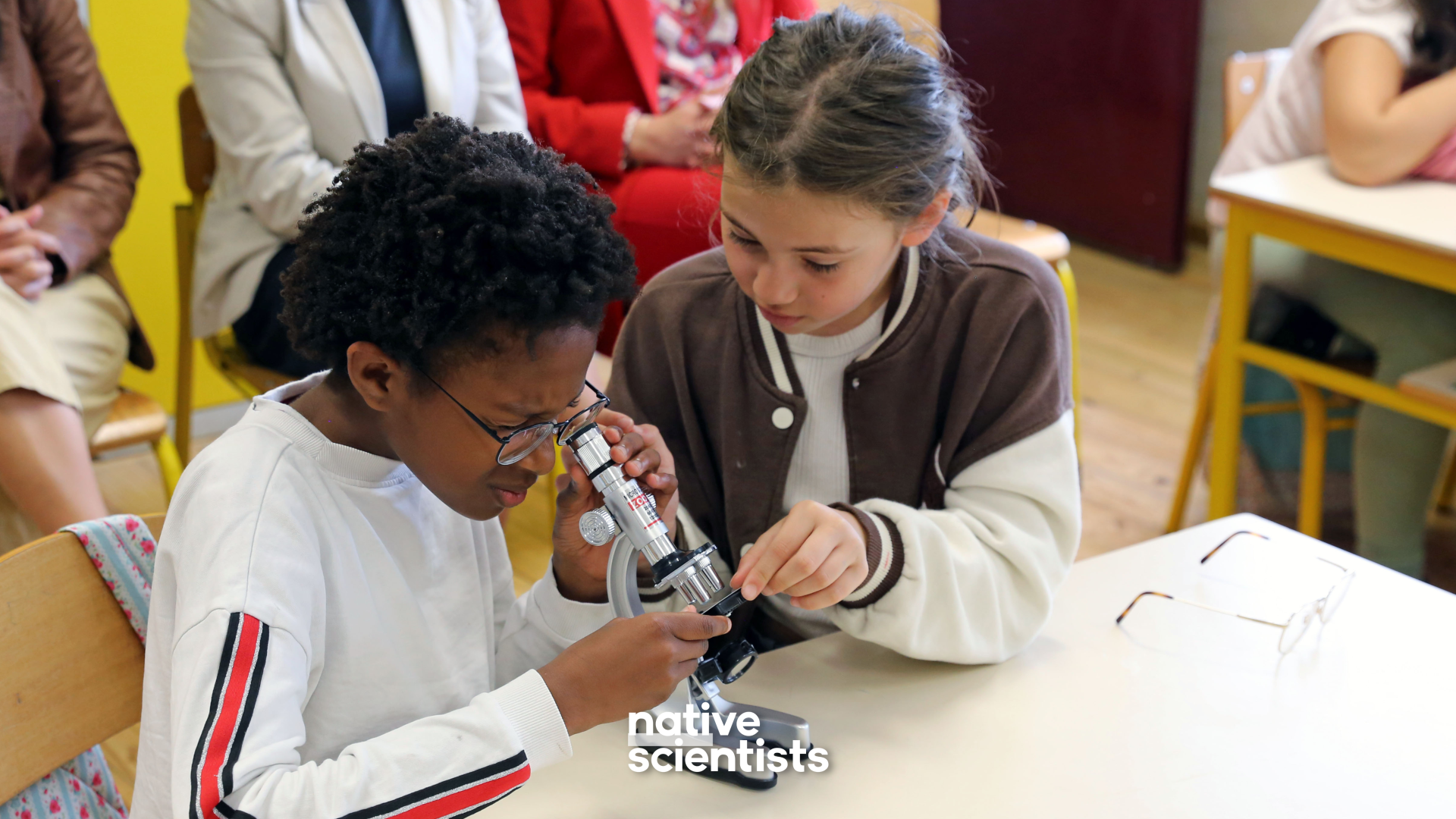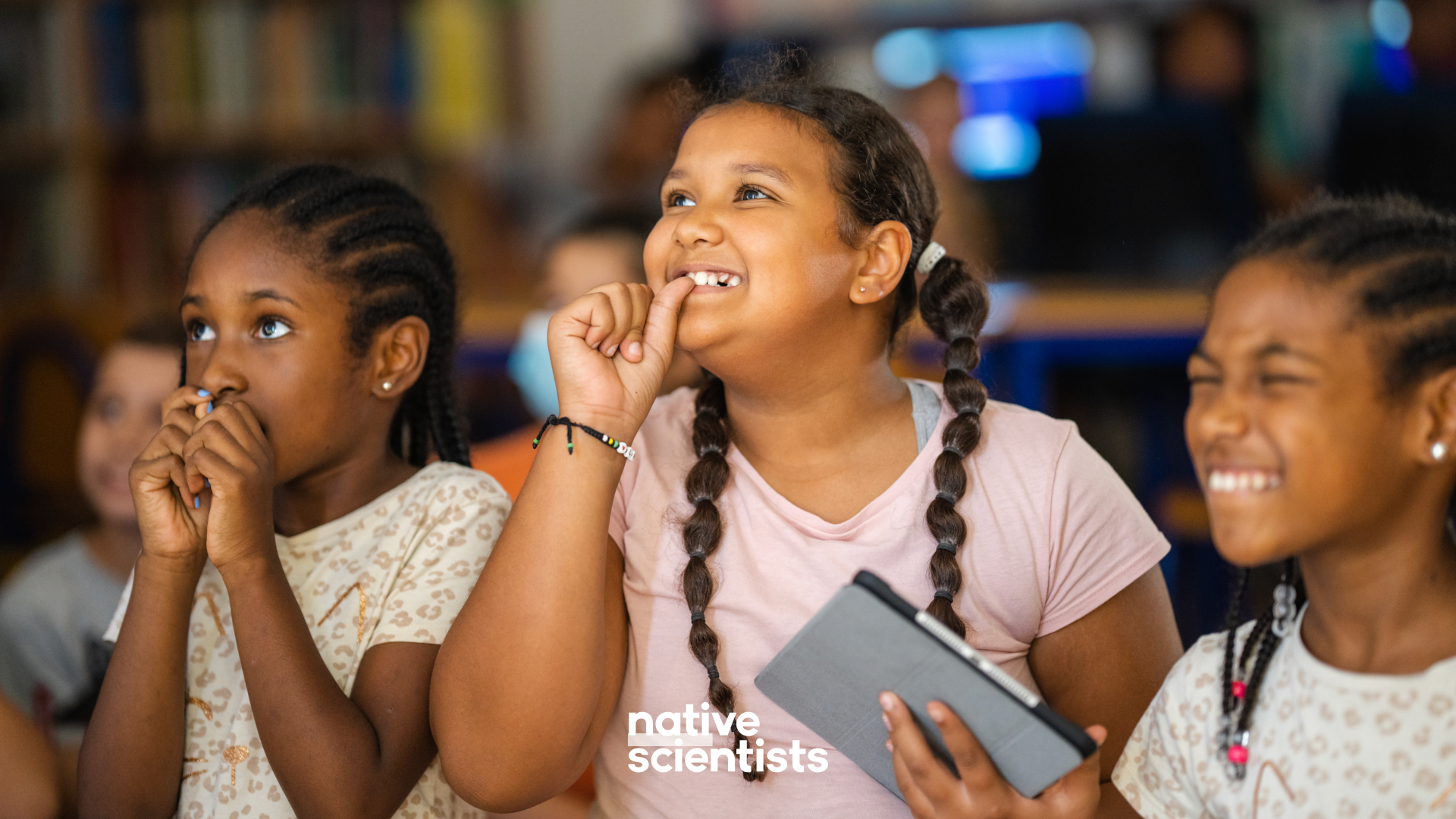Scientist Returns to School
Basic information
Project Title
Scientist Returns to School
Full project title
Scientist Returns to School
Category
Prioritising the places and people that need it the most
Project Description
Our project takes scientists back to their primary schools to deliver hands-on science workshops for students, building on the concept of Circular Education, where scientists give back to their communities. By prioritising rural areas, with lower access to science, meaningful connections between children and scientists with the same background were created. This helped students realise that “people like me can be a scientist” and develop positive attitudes towards science and higher education.
Geographical Scope
National
Project Region
Portugal
Urban or rural issues
Mainly rural
Physical or other transformations
It refers to other types of transformations (soft investment)
EU Programme or fund
Yes
Which funds
Horizon2020 / Horizon Europe
Description of the project
Summary
Scientists Return to School connects children and scientists from the same hometown to increase literacy in science, promote equal opportunities and increase the participation of scientists in society. This educational project is based on an innovative concept of Circular Education and promotes the return of scientists to their own primary schools to implement unique 90-minute-long hands-on science workshops with 4th-grade students. The project allows scientists to give back to their communities since through these workshops, scientists and pupils from the same hometown are brought together to exchange knowledge and have meaningful learning experiences. This project thus contributes to creating a more inclusive, sustainable and ultimately beautiful environment by empowering local communities through science education and transforming the traditional school classroom into a living lab of science knowledge and cultural identity.
Children relate to scientists who come from the same background as them, seeing them as role models and encouraging them to believe that science is achievable by all. During the past 2 years, our project has reached more than 1.500 children nationwide, prioritising those coming from rural, underprivileged, and/or underserved areas in Portugal. An impact assessment from an independent entity concludes that the project has effectively targeted children with lower exposure to science and to whom it was “very important” to meet a scientist. For 60% of the children, the programme was the first opportunity to meet and interact with a scientist. By increasing the participation of scientists in their hometowns, we broadened the horizons of underserved children and sparked their interest in science.
Children relate to scientists who come from the same background as them, seeing them as role models and encouraging them to believe that science is achievable by all. During the past 2 years, our project has reached more than 1.500 children nationwide, prioritising those coming from rural, underprivileged, and/or underserved areas in Portugal. An impact assessment from an independent entity concludes that the project has effectively targeted children with lower exposure to science and to whom it was “very important” to meet a scientist. For 60% of the children, the programme was the first opportunity to meet and interact with a scientist. By increasing the participation of scientists in their hometowns, we broadened the horizons of underserved children and sparked their interest in science.
Key objectives for sustainability
In terms of environmental sustainability, the key objectives of our initiative were, on the one hand, to have as little environmental impact as possible, and, on the other hand, to promote environmental sustainability consciousness through science education. Our team and practices are informed on the European Green Deal and the Sustainable Development Goals, namely 11 and 13, which relate to sustainable and environmentally friendly practices. Furthermore, we take into account the 5 R’s policy and we encourage the participating scientists to keep it in mind when designing and implementing their workshops. The team of Native Scientists works remotely and all the initiative was managed digitally using online videoconferencing and project management tools, which means that travel was reduced to the minimum.
When implementing the workshops in loco, public transportation was preferred, air travel was avoided and providers were chosen conscientiously. Workshop materials like stationary and scientific materials for hands-on activities were carefully selected in order to avoid using disposable, single-use materials, and to prioritise reuse.
Importantly, many of the workshops directly addressed topics related to sustainability, climate change, environmental pollution, circularity, biodiversity, and inclusion and access to natural resources. Scientists were encouraged to talk about their work addressing the world’s most pressing challenges and topics. Finally, local providers such as photographers and the local press were used, thus enhancing the local economy and reducing the pollution associated with long commutes.
When implementing the workshops in loco, public transportation was preferred, air travel was avoided and providers were chosen conscientiously. Workshop materials like stationary and scientific materials for hands-on activities were carefully selected in order to avoid using disposable, single-use materials, and to prioritise reuse.
Importantly, many of the workshops directly addressed topics related to sustainability, climate change, environmental pollution, circularity, biodiversity, and inclusion and access to natural resources. Scientists were encouraged to talk about their work addressing the world’s most pressing challenges and topics. Finally, local providers such as photographers and the local press were used, thus enhancing the local economy and reducing the pollution associated with long commutes.
Key objectives for aesthetics and quality
Key objectives of our initiative included: the children participating in the workshops are the ones with less exposure to science and scientific activities; these children learned new scientific concepts and developed a more positive attitude towards science; 60%+ met a scientist for the first time in their lives; teachers and scientists rated their experience positively and recommended it to their colleagues.
An impact assessment on this programme shows that 66% of the respondent children (n=375) reported it was “very important” to meet a scientist and 91% wanted to do more scientific activities outside of school, which suggests they were inspired for science and felt that science is relevant and important to them. Our goal of children realising that “people like me can be a scientist” and develop positive attitudes towards science was achieved, as 76.5% of children affirmed they could be a scientist if they wanted to.
On the other hand, scientists grasped how their participation in their communities is important and meaningful in order to bridge the gap between science and society and break stereotypes about science/scientists.
To increase impact, our workshops were carefully thought out and implemented to transform classes into a unique and attractive moment for children, where science is made beautiful and appealing through visual, interactive, or hands-on experiments. Importantly, they were supported by additional activities, including training for the scientists, pre and post-workshops using resources designed for the teachers, a gamified Scientists’ poster, and a nationwide contest for the best outputs of the pre-workshop.
Overall, the project narrowed the gap between the scientific and the educational communities by encouraging the engagement of scientists with their hometown communities, promoting the feeling that science is important for these children and that being a scientist is achievable for any of them, regardless of their background.
An impact assessment on this programme shows that 66% of the respondent children (n=375) reported it was “very important” to meet a scientist and 91% wanted to do more scientific activities outside of school, which suggests they were inspired for science and felt that science is relevant and important to them. Our goal of children realising that “people like me can be a scientist” and develop positive attitudes towards science was achieved, as 76.5% of children affirmed they could be a scientist if they wanted to.
On the other hand, scientists grasped how their participation in their communities is important and meaningful in order to bridge the gap between science and society and break stereotypes about science/scientists.
To increase impact, our workshops were carefully thought out and implemented to transform classes into a unique and attractive moment for children, where science is made beautiful and appealing through visual, interactive, or hands-on experiments. Importantly, they were supported by additional activities, including training for the scientists, pre and post-workshops using resources designed for the teachers, a gamified Scientists’ poster, and a nationwide contest for the best outputs of the pre-workshop.
Overall, the project narrowed the gap between the scientific and the educational communities by encouraging the engagement of scientists with their hometown communities, promoting the feeling that science is important for these children and that being a scientist is achievable for any of them, regardless of their background.
Key objectives for inclusion
Both our organisation and this project were built on equity, diversity and inclusion values. We know that greater diversity leads to greater results and that representation is key to fostering a sense of belonging and inclusion, as well as a unified and engaging society. At an organisational level, our goal is to promote fair and quality science education, to have a diverse team, and to promote decent work conditions. In line with EU policies, we are (1) creating an equity and diversity plan for the organisation, (2) aiming to increase the opportunities for underserved communities by involving their own citizens, and (3) having a policy to make sure that our activities are always free for students and their families, thus allowing every child to participate despite their socio-economic status.
The activities took place in schools considered to be of priority intervention, i.e., schools from underserved areas, like:
Schools in Areas with Very Low Population Density;
Schools with Negative Equity Rates according to data published by the Portuguese Ministry of Education;
Schools with High Student Rates in Free School Meals;
Schools in the Ultra Peripheral Regions of the EU (Azores and Madeira).
The fact that scientists returned to their hometowns meant that the project decentralised science communication and education activities from the great urban areas, where the scientists typically work and where the science centres, universities or museums are often found. In the long run, we hope to see this concept replicated in other underserved areas reaching children regardless of gender, race, ethnicity, origin, religion or economic status. During the implementation (2022) and consolidation (2023) of this project, we designed a plan that allowed us to ensure viability and financial sustainability through a mix of fees-for-service paid by municipalities or regional governments, private contributions, and grants/prizes such as this one, that can leverage scalability.
The activities took place in schools considered to be of priority intervention, i.e., schools from underserved areas, like:
Schools in Areas with Very Low Population Density;
Schools with Negative Equity Rates according to data published by the Portuguese Ministry of Education;
Schools with High Student Rates in Free School Meals;
Schools in the Ultra Peripheral Regions of the EU (Azores and Madeira).
The fact that scientists returned to their hometowns meant that the project decentralised science communication and education activities from the great urban areas, where the scientists typically work and where the science centres, universities or museums are often found. In the long run, we hope to see this concept replicated in other underserved areas reaching children regardless of gender, race, ethnicity, origin, religion or economic status. During the implementation (2022) and consolidation (2023) of this project, we designed a plan that allowed us to ensure viability and financial sustainability through a mix of fees-for-service paid by municipalities or regional governments, private contributions, and grants/prizes such as this one, that can leverage scalability.
Results in relation to category
In the 2023 report Portugal Balanço Social it is outlined that the most underprivileged students are 2.8 times more likely to have below-average skills in sciences. The report shows that geographic location and socioeconomic context are preponderant factors when it comes to inequalities in education and access to science. With this in mind, our project’s prime goal has always been to promote equal opportunities and quality education for children with low exposure to science. Thus, our priority was to reach underserved communities in Portugal. According to an impact report, our project effectively reached children with low levels of pre-existing engagement with science, but who are very interested in doing more of these activities. 60% of the respondents (n=375)affirmed that it was their first time meeting a scientist in their lives, and 2/3 said it was “very important” to meet a scientist.These results display that most of the children developed a positive attitude towards science, created a meaningful connection with the scientist and learned new concepts. Furthermore, 76% of the children reported “they could be a scientist” if they wanted to.Our expectation is that, by developing this connection, broadening their horizons and realising higher education is a possibility, we help children from underserved contexts break vicious circles of poverty in the future.The project also targets the scientific community: scientists reported developments in their ability to communicate with non-specialists about science and reported gaining a new perspective on the importance of their work. The majority of scientists and teachers said they would like to participate in the project in the following years.The communities also benefit from our project: parents have a higher understanding of what their children like and dislike; municipalities strengthen their relations with research institutes/universities; and conversations around science are more prone to happen in everyday life.
How Citizens benefit
The citizens benefiting most from this project were mostly students and the scientists coming from underserved areas of Portugal. They were involved from the start of the project (through interviews) all the way to implementation (through workshops) and evaluation (through questionnaires and focus groups). Without their involvement, this programme would not have been possible.
An impact assessment (by a third party) indicates that 76,5% of the respondent children (n=375) now realise that “people like me can be a scientist” and developed positive attitudes towards science, with the majority of them saying they wanted to do more scientific activities. Scientists had the opportunity to give back to their communities, as they acted as role models for the new generations and received training in science communication, which they reported as important to develop communication skills.
The teachers and the parents were also involved and impacted, as they were mediators and hosts of the scientist's visit to the school. 96% of the teachers would recommend it to a colleague and would like to repeat the experience. They say “the fact it was implemented by someone who attended this school was an added value” and “the workshop allowed the students to interact with real scientists and manipulate resources we don’t have at school.” Other members of the community, such as local photographers and journalists were also indirectly impacted. The initiative fostered the establishment of closer relations between different members of society, it increased the conversations regarding science topics or scientists, at home, school or in the local community, creating a multiplying effect, thus contributing to the creation of solid bridges between the scientific and the school communities and to the promotion of active and conscious citizenship in future generations. At a larger level, this can have an impact on Portugal’s scientific field/professions in the future.
An impact assessment (by a third party) indicates that 76,5% of the respondent children (n=375) now realise that “people like me can be a scientist” and developed positive attitudes towards science, with the majority of them saying they wanted to do more scientific activities. Scientists had the opportunity to give back to their communities, as they acted as role models for the new generations and received training in science communication, which they reported as important to develop communication skills.
The teachers and the parents were also involved and impacted, as they were mediators and hosts of the scientist's visit to the school. 96% of the teachers would recommend it to a colleague and would like to repeat the experience. They say “the fact it was implemented by someone who attended this school was an added value” and “the workshop allowed the students to interact with real scientists and manipulate resources we don’t have at school.” Other members of the community, such as local photographers and journalists were also indirectly impacted. The initiative fostered the establishment of closer relations between different members of society, it increased the conversations regarding science topics or scientists, at home, school or in the local community, creating a multiplying effect, thus contributing to the creation of solid bridges between the scientific and the school communities and to the promotion of active and conscious citizenship in future generations. At a larger level, this can have an impact on Portugal’s scientific field/professions in the future.
Physical or other transformations
It refers to other types of transformations (soft investment)
Innovative character
There is a growing number of initiatives that promote science education but what distinguishes this project from others is that (1) it was built on equity, diversity, inclusion values (in many other initiatives this is either absent or is an afterthought), (2) it highly dependent on civic participation and engagement, fostering learning by bringing children and scientists together, who share common cultural and socioeconomic background, and using novel and non-formal ways of teaching, and (3) it was developed alongside a solid long-term vision and financial sustainability plan. In terms of methodology, the innovative character of the project had centre stage in three main pillars:
(1) the use of evidence-based education methodologies and training approaches, including the Science Capital and the “Science Capital Teaching Approach”, developed by Prof Dr Louise Archer and colleagues and described below;
(2) the promotion of Circular Education, where scientists return to their own primary schools and give back to their hometowns’ future generation. Granting the project a strong local/circular approach, with an emotional component for those participating in it, and with the ability to be scalable nationwide or to be implemented in other countries. We aim to guarantee that all children in Portugal have the possibility of interacting with a scientist.
(3) decentralise access to science – we promoted equity by giving access to science education in communities that are greatly lacking these initiatives. We turn vicious cycles into virtuous cycles, by taking scientists to more deprived areas in terms of science enrichment programmes, instead of waiting for these students or their families to reach them, since they usually do not seek this kind of activities.
(1) the use of evidence-based education methodologies and training approaches, including the Science Capital and the “Science Capital Teaching Approach”, developed by Prof Dr Louise Archer and colleagues and described below;
(2) the promotion of Circular Education, where scientists return to their own primary schools and give back to their hometowns’ future generation. Granting the project a strong local/circular approach, with an emotional component for those participating in it, and with the ability to be scalable nationwide or to be implemented in other countries. We aim to guarantee that all children in Portugal have the possibility of interacting with a scientist.
(3) decentralise access to science – we promoted equity by giving access to science education in communities that are greatly lacking these initiatives. We turn vicious cycles into virtuous cycles, by taking scientists to more deprived areas in terms of science enrichment programmes, instead of waiting for these students or their families to reach them, since they usually do not seek this kind of activities.
Disciplines/knowledge reflected
This project was an entirely new concept involving a science enrichment programme, at the intersection of three fields:Education, Science, and Social Innovation and Participation. It was a local and nationwide initiative, embracing rural and underserved communities as a priority, where scientists and students from the same hometown were brought together within the school environment to have meaningful dialogues about science.During the design and implementation of the project, a multidisciplinary team was established, with members from different academic backgrounds (from social entrepreneurship and design to biology and psychology) and with different approaches to participation in society.Secondly, in our workshops, scientists from any field of expertise or career stage were encouraged to participate, showcasing how different scientific disciplines play a role in society, giving a renewed value to their work and inspiring children to reach for their goals.The project included a gamified poster where students discovered the different disciplines of the scientists who participated in each edition of the project. For instance, in the pilot edition, 15scientists from Portugal's mainland and Azores participated, covering a total of 15different science topics, including bacteria, robots, architecture and language.Last year, 33scientists participated, expanding to Madeira Island and other municipalities.Thirdly, the organisation behind this initiative is a pan-european organisation with a multidisciplinary and multicultural team.It is in a constant state of intellectual refinement nurtured by specialists from different fields.Because of the intersectionality and interdisciplinarity of the organisation and the initiative, its innovative approach and also the fact that equity, diversity, inclusion and civic participation values are at the core, the organisation behind the programme is an award-winning organisation and has received in 2022 a prestigious UNESCO Literacy Prize
Methodology used
The project was rooted in evidence-based approaches, including:
Science Capital Teaching Approach (Prof Dr Louise Archer et al). In this methodology, science is seen as a vehicle to promote social justice. Outreach and education programmes focus on allowing students to create meaningful connections with science, making them relevant. These initiatives need to be accessible to every child, especially those living in underserved areas, with a lower exposure to science.
Inquiry-based science education, project-based learning, content and language integrated learning, and co-production of pedagogical methods. Students learn better when they are part of the process, when multimodal input is used and when they build upon prior knowledge, skills, and interests. These methodologies allow students to create more relevant connections with science and build a humanised picture of science. It allows students to deconstruct stereotypes, realising that science is not for an elite. Plus, their contact with science is authentic and generates positive memories, as they are co-creators of their acquired knowledge. Circular science/education, a concept borrowed from circular economy, highlights the importance of thinking about the whole lifecycle of a product/service. In this case, it reflects the idea of going back to our roots and giving back to the community, especially the young generations, thus contributing to inverting vicious cycles into virtuous cycles, helping young people to exit situations of poverty and social exclusion, and being a role model.Critical pedagogy, where students and instructors work together to produce knowledge, in a holistic educational approach that can be transformative. Emphasis is given to identities and human needs/contexts to foster critical thinking, argumentation and empathy in students.During the workshops, children are encouraged to engage and participate, and after the workshop, they are challenged to create a project about their experience.
Science Capital Teaching Approach (Prof Dr Louise Archer et al). In this methodology, science is seen as a vehicle to promote social justice. Outreach and education programmes focus on allowing students to create meaningful connections with science, making them relevant. These initiatives need to be accessible to every child, especially those living in underserved areas, with a lower exposure to science.
Inquiry-based science education, project-based learning, content and language integrated learning, and co-production of pedagogical methods. Students learn better when they are part of the process, when multimodal input is used and when they build upon prior knowledge, skills, and interests. These methodologies allow students to create more relevant connections with science and build a humanised picture of science. It allows students to deconstruct stereotypes, realising that science is not for an elite. Plus, their contact with science is authentic and generates positive memories, as they are co-creators of their acquired knowledge. Circular science/education, a concept borrowed from circular economy, highlights the importance of thinking about the whole lifecycle of a product/service. In this case, it reflects the idea of going back to our roots and giving back to the community, especially the young generations, thus contributing to inverting vicious cycles into virtuous cycles, helping young people to exit situations of poverty and social exclusion, and being a role model.Critical pedagogy, where students and instructors work together to produce knowledge, in a holistic educational approach that can be transformative. Emphasis is given to identities and human needs/contexts to foster critical thinking, argumentation and empathy in students.During the workshops, children are encouraged to engage and participate, and after the workshop, they are challenged to create a project about their experience.
How stakeholders are engaged
Our organisation has a growth mindset, we practice co-production and have a collaborative approach. All stakeholders were engaged in the project from the design to implementation. The design included interviews with 5-10 people/entities for each type of stakeholder they were kept engaged through regular emails, meetings, questionnaires and/or volunteering. The stakeholders are:
Students, the heroes and beneficiaries of the initiative. This project was developed for 4th graders, and we gathered information about each class of students from their teachers. We also trained the scientists to engage students in active and inquiry-based learning. We wanted to promote the children’s interest and curiosity around science, broaden their horizons and make them actively participating citizens. Scientists, the lifeblood of the initiative. They received training, 1:1 support from experienced science communicators and learned how to best communicate their work. Scientists participated in focus groups and had the opportunity to give feedback. The impact assessment carried out shows they feel their work is valued and that they benefited from this experience. Universities and Research Insitutitions, the dissemination partners. They helped us spread the word among their community of scientists and disseminated the project In return, the work of their scientists was spread across communities. Teachers, Schools and Ministry of Education, the key mediators of the interventions. They implemented the pre and post-workshop activities and further support students' interest in science. Municipalities and Regional Governments, the enablers. They paid for the project and engage local providers, making science accessible for all in their communities. Children’s families - the key supporting element. Through the pre and post-workshop activities, families were involved and deepened their understanding of what enthuses their child, talked about science at home, and felt closer to science.
Students, the heroes and beneficiaries of the initiative. This project was developed for 4th graders, and we gathered information about each class of students from their teachers. We also trained the scientists to engage students in active and inquiry-based learning. We wanted to promote the children’s interest and curiosity around science, broaden their horizons and make them actively participating citizens. Scientists, the lifeblood of the initiative. They received training, 1:1 support from experienced science communicators and learned how to best communicate their work. Scientists participated in focus groups and had the opportunity to give feedback. The impact assessment carried out shows they feel their work is valued and that they benefited from this experience. Universities and Research Insitutitions, the dissemination partners. They helped us spread the word among their community of scientists and disseminated the project In return, the work of their scientists was spread across communities. Teachers, Schools and Ministry of Education, the key mediators of the interventions. They implemented the pre and post-workshop activities and further support students' interest in science. Municipalities and Regional Governments, the enablers. They paid for the project and engage local providers, making science accessible for all in their communities. Children’s families - the key supporting element. Through the pre and post-workshop activities, families were involved and deepened their understanding of what enthuses their child, talked about science at home, and felt closer to science.
Global challenges
The project directly contributed to promoting fair and quality science education and reducing inequalities in Portugal (islands included). We designed this to address three main challenges, namely:
- inequities in children’s access to science based on their hometown (and social-economic status)
- stereotypes about science professionals and gender disparities
- sharp decline in interest in science at the ages 10-12
By implementing science workshops throughout the Portuguese territory, and mainly in areas with less access to science and science engagement activities, the project guaranteed access to inclusive, quality and equitable education as we reached areas considered to be of priority intervention. By demonstrating that every child, regardless of where they live or are born, can possibly attend Higher Education, we contributed to equal access to the various levels of education, mainly for children and people in more peripheral/rural areas, in situations of greater vulnerability and/or more sensitive socio-economic contexts (the Azores and Madeira Islands are considered ultra peripheral regions of the EU, and the poorest regions of Portugal, according to the 2023 report “Portugal Balanço Social”).
Our mission included breaking stereotypes about scientists (i.e., the idea of a male scientist in a white coat and with grey hair), and therefore to contribute to eliminating gender disparities (girls can also be scientists and engineers) and also stereotypes about science (the social sciences, arts and humanities are also areas of scientific knowledge; science is for an elite and only them can be scientists).
Finally, we targeted 4th-grade students as there is evidence that children's interest in science starts to decline around the age of 10-12 years. We wanted to take action prior to this decline, encouraging them to keep their enthusiasm and curiosity towards different fields.
- inequities in children’s access to science based on their hometown (and social-economic status)
- stereotypes about science professionals and gender disparities
- sharp decline in interest in science at the ages 10-12
By implementing science workshops throughout the Portuguese territory, and mainly in areas with less access to science and science engagement activities, the project guaranteed access to inclusive, quality and equitable education as we reached areas considered to be of priority intervention. By demonstrating that every child, regardless of where they live or are born, can possibly attend Higher Education, we contributed to equal access to the various levels of education, mainly for children and people in more peripheral/rural areas, in situations of greater vulnerability and/or more sensitive socio-economic contexts (the Azores and Madeira Islands are considered ultra peripheral regions of the EU, and the poorest regions of Portugal, according to the 2023 report “Portugal Balanço Social”).
Our mission included breaking stereotypes about scientists (i.e., the idea of a male scientist in a white coat and with grey hair), and therefore to contribute to eliminating gender disparities (girls can also be scientists and engineers) and also stereotypes about science (the social sciences, arts and humanities are also areas of scientific knowledge; science is for an elite and only them can be scientists).
Finally, we targeted 4th-grade students as there is evidence that children's interest in science starts to decline around the age of 10-12 years. We wanted to take action prior to this decline, encouraging them to keep their enthusiasm and curiosity towards different fields.
Learning transferred to other parties
The project was launched on September 8, 2021 in rural communities in Portugal, having been implemented in the 2021/22 school year for the first time. In 2022/23 we doubled the number of children who learned and interacted with a scientist, with the objective of studying and developing a good consolidation plan. The mentioned impact assessment suggests that the pilot and consolidation editions were successful in reaching the project’s goals. Through our carefully thought and financially sustainability plan, we suggest the project can be replicated and escalated. In our pilot year, we had financial support from 25% of the municipalities where the project was implemented. In 2023, we doubled the number of municipalities reached by the project, but kept a rate of 25% of supporting municipalities. The municipalities who first get the project for free are more keen on supporting it in the next years. Thus, we suggest that the project and the concept of circular education can be replicated in other communities and even countries.
By learning from the previous completed editions, we hope to make Portugal the first country where no child goes through primary education without ever meeting a scientist from their hometown.
In the Azores Islands, for example, the initiative was such a success that from 2021/22 to 2022/23, meeting a scientist from their community was made possible for all 4th graders in 3 out of the 9 islands. Considering the successful pilot and consolidation year of the project in Portugal, the possibility of rolling out the initiative to Spain is being explored. If one considers no budget limitations, it can in theory be replicated in most EU countries.
By learning from the previous completed editions, we hope to make Portugal the first country where no child goes through primary education without ever meeting a scientist from their hometown.
In the Azores Islands, for example, the initiative was such a success that from 2021/22 to 2022/23, meeting a scientist from their community was made possible for all 4th graders in 3 out of the 9 islands. Considering the successful pilot and consolidation year of the project in Portugal, the possibility of rolling out the initiative to Spain is being explored. If one considers no budget limitations, it can in theory be replicated in most EU countries.
Keywords
Circular Education
Accessible Science
Quality and fair education
Inclusive community engagement;
Intergenerational connections

